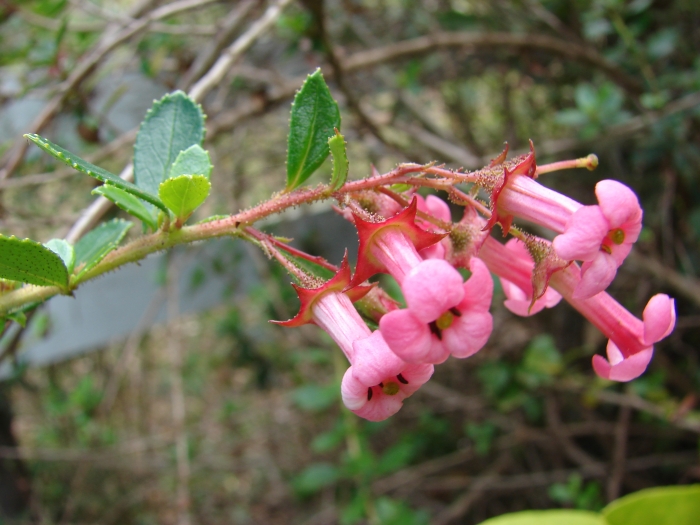Redclaws
(Escallonia rubra)
Redclaws (Escallonia rubra)
/
/

Forest & Kim Starr
CC BY 3.0
Image By:
Forest & Kim Starr
Recorded By:
Copyright:
CC BY 3.0
Copyright Notice:
Photo by: Forest & Kim Starr | License Type: CC BY 3.0 | License URL: https://creativecommons.org/licenses/by/3.0 | Uploader: BotMultichillT | Publisher: Wikimedia Commons | Title: Starr_080716-9454_Escallonia_rubra_var._macrantha.jpg | Notes: |





















































Estimated Native Range
Summary
Escallonia rubra, commonly known as Redclaws, is an evergreen shrub native to the temperate forests of Chile and Argentina. It typically grows to 0.8 to 1.0 meters tall but can reach heights of up to 3.6 meters. The plant has a spreading habit and features glossy, elliptical, serrate leaves that are dark green on the upper side and much lighter underneath. The bark of young stems is red and rough-haired, maturing to brown with dots and eventually turning gray and cracked. The root system initially consists of stringy roots, which later develop into strong main roots that lie high in the soil. Redclaws is known for its showy pink to crimson trumpet-shaped flowers, which bloom from July to October in the Northern Hemisphere and sit in short clusters from the leaf corners. The flowers have a short tubular shape, and the fruits are capsules.
Redclaws is valued for its ornamental flowers and is used as a garden plant and for hedging. It is particularly appreciated for its long flowering season and the contrast between its dark foliage and bright flowers. In cultivation, it prefers full sun to part shade, well-drained soil, and moderate watering. While it can tolerate a range of soil types, it thrives in fertile, humus-rich soils. It is also salt-tolerant, making it suitable for coastal gardens. However, gardeners should be aware that Escallonia rubra can be potentially invasive when grown outside its native range, so it is important to check local regulations before planting.CC BY-SA 4.0
Redclaws is valued for its ornamental flowers and is used as a garden plant and for hedging. It is particularly appreciated for its long flowering season and the contrast between its dark foliage and bright flowers. In cultivation, it prefers full sun to part shade, well-drained soil, and moderate watering. While it can tolerate a range of soil types, it thrives in fertile, humus-rich soils. It is also salt-tolerant, making it suitable for coastal gardens. However, gardeners should be aware that Escallonia rubra can be potentially invasive when grown outside its native range, so it is important to check local regulations before planting.CC BY-SA 4.0
Plant Description
- Plant Type: Shrub
- Height: 10-15 feet
- Width: 5-10 feet
- Growth Rate: Rapid
- Flower Color: Pink, Red
- Flowering Season: Summer, Fall
- Leaf Retention: Evergreen
Growth Requirements
- Sun: Full Sun, Part Shade
- Water: Medium
- Drainage: Fast, Medium
Common Uses
Bee Garden, Hedges, Low Maintenance, Salt Tolerant, Showy Flowers, Street Planting
Natural Habitat
Temperate forests of Chile and Argentina
Other Names
Common Names: Red Escallonia , Röd Escallonia
Scientific Names: Escallonia rubra , Escallonia macrantha , Escallonia rubra var. glabriuscula , Escallonia rubra var. rubra , Escallonia littoralis , Escallonia punctata , Stereoxylon rubrum , Escallonia ingrami , Escallonia duplicato-serrata , Escallonia glandulosa
GBIF Accepted Name: Escallonia rubra (Ruiz & Pav.) Pers.